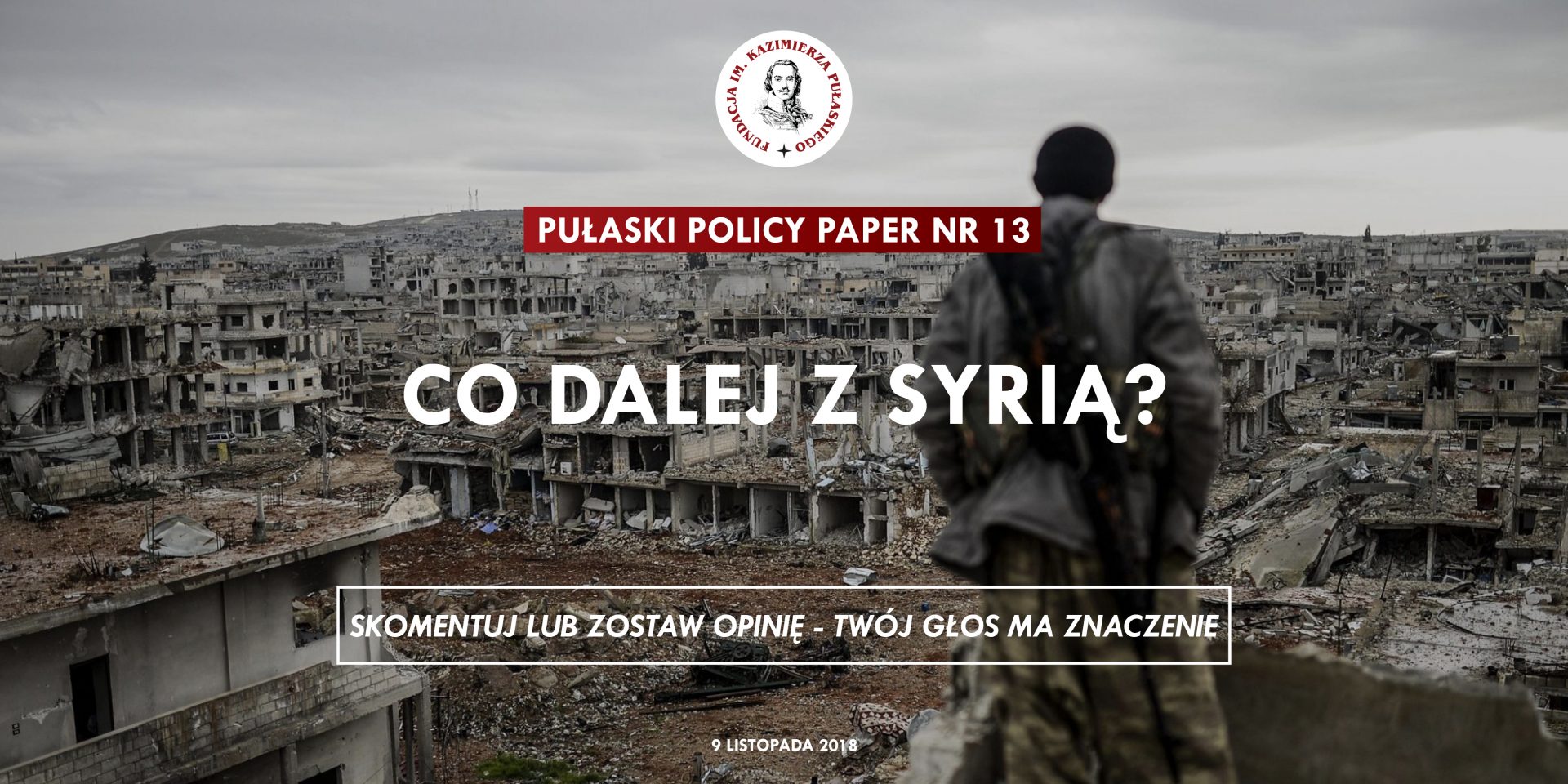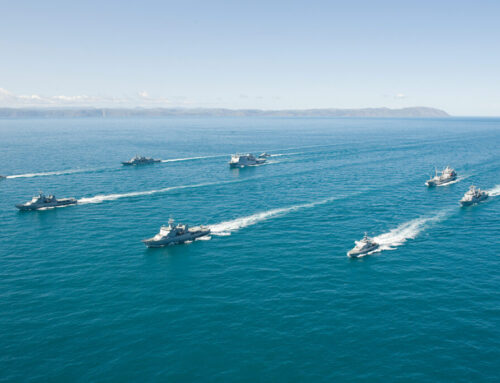PPP_13
Autor foto: Domena publiczna

What’s next for Syria?
November 9, 2018
Author: Tomasz Otłowski




PPP_13
Autor foto: Domena publiczna
What’s next for Syria?
Author: Tomasz Otłowski
Published: November 9, 2018
Pułaski Policy Paper No. 13, 2018. November 9th, 2018
After seven years of a bloody civil war, Syrian conflict is coming to an end and a new order emerging. Ba’ath party regime has managed – with the help from regional and global allies – to survive the revolutionary upheaval of Sunni minority, which was also supported by foreign states. President Bashar al-Assad maintained control over the country and leadership of his political base, which suggests that the government in Damascus will remain unchanged for the foreseeable future. However, the internal – social and political – situation in Syria may undergo fundamental changes. Moreover, the complicated network of alliances and interdependencies between the Syrian regime and its regional and global supporters, which emerged over the past few years, will continue to weight on the strategic situation in Levant and on Syria’s position in the Middle East.
Internal situation – marginalization of Sunnites, rise of the Kurds and increasing influence of the criminal element over Syrian regime
The war transformed the Syrian society in many ways. The mere effect of the wartime “demographic crump” has been devastating, claiming more than half a million of casualties, while around 1 million of Syrians were wounded, 6-7 million internally displaced and almost 6 million are seeking refuge (official UN data – some unofficial estimates put the number of refugees at almost 10 million) in Turkey, Lebanon, Jordan and Iraq. Most of the displaced are Sunni, which affects the internal demographic composition. While Sunnites are still a majority (58% now, as compared with 70% before the war), the other religious groups (Alawites, Shiite, Christians and Druze) now represent a larger percentage of country’s population. Moreover, most of the internally displaced are members of religious minorities. These factors, combined with the fact that the rebellion against Assad was mostly driven by Sunnites, shapes the new internal political order in Syria. The current geographic dislocation of religious groups is significantly different than before the war. The Sunnites who decided to stay in Syria were pushed out of the western, more urbanized and developed part of the country. Alawites now represent a larger share of population in their indigenous regions of Latakia and Tartus, as well as in Damascus. The capital was also a wartime haven for many Syrian Shiites and Christians, who were expelled from other parts of the country by rebels and Islamic fundamentalists. The brutal civil war also affected the demographics of Sunni strongholds – cities of Homs, Hama, Aleppo and Dara. The overall population of these urban centers decreased dramatically, while most of the refugees (or those driven out during religious cleansings) were Sunnites. Due to the extent of wartime damages, the reconstruction and repopulation of these (and other) cities will take years.
The post-war reconstruction is at the centre of the complicated political game in Syria. With Bashar’s regime having the upper hand, foreign companies are eyeing possible contracts for reconstruction of infrastructure. Consortia from Russia and Iran are leading the way, but enterprises from China, India and even South Africa are also interested in rebuilding the war-torn state. The order of planned investments is the political question at stake. According to well-informed sources in Damascus, priority will be given to Alawite-dominated regions and Shiites who stayed loyal to Assad. Next in line will be areas inhabited by those ethnic groups, which remained neutral during the conflict (Christians and Druze minority from As-Suwayda) and elements of communication infrastructure, such as highways and bridges. Government is also set on restoring the pre-war oil and gas production capacities in the areas which it controls, that is in the eastern Homs province (the Palmira region). Little attention is given to investments in the areas traditionally controlled by the Sunnites. This resembles the practice used by the government in Bagdad against the Iraqi Sunnites – cities of Ramadi, Fallujah or Tikrit are still in ruins, while the local – mostly Sunni – populations have been neglected.
Repressions against suspected members of the rebellion or opposition supporters are an indispensable element of Damascus’ the anti-Sunni policy. In fact, after 7 years of a blood religious conflict, nearly every male Sunnite in the conscription age is treated as a potential rebel, or an outright Islamic extremist. It is therefore no surprise, that the relocation of refugees back to the Syria, proposed by Russia and Turkey, is becoming increasingly more difficult. Syrian Sunnites do not want to return to a country where they face prison and tortures, and where the government withholds basic social and humanitarian aid.
As a result, the Sunnites are marginalized and deprived of a voice in the “political dialogue” currently underway in Syria. The few figurehead Sunnites formally engaged in the process aren’t legitimate representatives of the minority. Many of them are known regime supporters from pre-war times.
The new Syrian demographics is even more favourable for Damascus, since 20% of the Sunnite population is actually Kurdish. Thus far, the Kurds have been observing the informal non-aggression pact with the regime. It is likely that Assad’s “New Syria” order foresees some kind of extended local self-governance proposal for this minority, to be granted in exchange for renouncing any intentions for an autonomy or independence. With American and Turkish forces currently present on Kurdish territories, Damascus’ moves are limited. Instead, Assad’s regime is set on regaining control of the Idlib province, the last Sunni and mostly Arab stronghold in Syria.
An important, and largely unnoticed in the West, factor currently shaping the political situation in Syria, is Damascus’ increasing dependence on radical and criminal elements of Shiite and Alawite communities. While regime’s military advances would not be possible without the arms and materiel from Russia and Iran, the systematic recruitment of local, Alawite and Shiite (and to a lesser extent, Druze) clan members was the deciding factor for Assad’s war victory. Damascus won over the clans and their members – which usually focus on smuggling and remain outside of official state structures – with Iran-provided funds. The new volunteers were grouped in paramilitary units, forming the IV (formed in 2015) and V (2016) Corps of the Syrian Armed Forces, and soon proved to be a prized battle asset. With training and equipment from Russia and Iran, both Corps enabled the regime to successfully conduct several offensive operations against rebels and extremists in the last two years. Now Damascus will have to pay a high price for this support, granting the clans with informal concessions and privileges, including those related to their traditional trade (smuggling of goods from Lebanon and Jordan, drug and arms trade, etc.). This would hardly be the first such situation in Syria: at the beginning of the civil war (years 2011-2012) the Syrian government made similar concessions to the members of the infamous Shabiha commandos – informal, pro-regime militia, tasked with pacifying and breaking down anti-government protests. Many of the former, high-ranking Shabiha members are now commanding units within the IV and V Corps. Others became important figures in the Ba’ath party or regime-controlled security services, which draws government agencies closer to the criminal underground of the Levant (similar processes took place in 1990s, following the Lebanon war). Therefore, there is a serious risk that following the civil war victory the Damascus regime will become more criminal in nature. This could turn out to be more dangerous than regime’s lack of democratic legitimacy, which is often named as number one concern by Western analysts. Undemocratic governments are the norm in the Middle East, while systemic interdependence of a country with regional (and larger) mafias constitutes a grave challenge.
International situation – strategic victories of Iran and Russia, pyrrhic victory of Turkey and Saudi’s defeat.
The Islamic Republic of Iran (IRI) came out as the main winner of the Syrian civil war. Tehran managed to achieve most of its strategic goals, such as assuming an informal “leadership” over Syrian Shiites and Alawites. Moreover, Iranians took advantage – or even orchestrated – of the events during the conflict to become the main allies of Damascus. In 2012, long before Russian military contingent arrived in Syria, Tehran sent first instructors and volunteer fighters to protect Shiite holy sites. At the same time, fighters affiliated with Lebanon’s pro-Iranian Hezbollah, reinforced regime forces on many warfronts.
Over the following years, the Iran’s involvement of Iran in Syria continued to increase along with political appetite to ensure the new, post-war order is favourable to Tehran. The highest point of order is Syria’s location vis-a-vis the areas of strategic importance – the Levant (Palestine, Lebanon) and Israel. Between 2015 and 2018 Iran finally succeeded to build a geopolitical structure called the „Shiite crescent”, that is, a strip of lands inhabited mostly by Shiites and influenced (or even politically controlled) by Iran. Tehran has been striving to achieve this goal since the 1979 revolution. Therefore, it is unlikely to it give up now, even when faced with pressure from hitherto allies – Russia and Turkey. Iranians may have agreed to close those military bases and installations in Syria, which are in direct vicinity of Israel, but will not abandon the Syrian land bridge to their outposts in Iraq and Lebanon. They will also hold on to the strategic plan to outflank Israel. The annihilation of the Hebrew state is still a top priority for the Islamic Republic.
Damascus recognizes the volatility of the strategic situation in the country, and the risk of the war tide turning against Assad’s forces. Therefore, Syrians need Iran support in recruiting Shiite militias, which are trained and commanded by Iranian Quds Brigades and bear much of the war effort on Syrian fronts. On the other hand, these formations (currently estimated at 50,000 trained, seasoned in battle and fanatic soldiers) cannot be taken lightly. They remain unequivocally loyal to Tehran, and outside of any control by Damascus. While Hezbollah formations are gradually pulling out of the country, the Shiite volunteers hold their position and are an increasing nuisance for the local communities. This is because they come from culturally different parts of the world, such as Pakistan and Afghanistan. The militias remain a key Iranian asset and can play a decisive role in the battle for the future of Syria.
Russia is undoubtedly the biggest winner of the war among global powers. By taking an unwavering political stance and providing adamant military support for Damascus since 2015, Moscow proved to be a reliable partner for its Middle Eastern allies. What’s more, Russians supported the geopolitical status quo in the region, which is very important for most of the regional governments that stray from any reforms, particularly the “democratizing” efforts promoted by the West. Thus, Russia gained the trust of several local regimes and increased its political and economic capabilities in the region. In Syria, Moscow is – and will be in the foreseeable future – the key underwriter of Assad’s regime. Russia also became the playmaker vis-à-vis other powers – the United States, Israel, Western Europe, Turkey and Iran – holding the upper hand in Syrian issues. This is very troubling for Washington and the European Union, who are unable to challenge Russian dominance. Another benefit for Moscow is the unlimited – in time and scale – access to military installations in Tartus (naval base) and Khmeimim (air and special forces base). Lastly, Russian troops gained valuable military experience from operations in Syria, which has a positive effect on the modernization and training process of the Russian Armed Forces.
Turkey can feel defeated in Syria. Ankara it risked all by trying to achieve several strategic goals at the same time – toppling (or weakening) Assad’s regime, scattering Kurdish dreams of independence or autonomy, and defeating the Islamic State in northern Syria. These goals turned out to be largely conflicting. While the Turks managed to weaken the Kurds and remove the ISIS threat, the costs of doing so came up prohibitively high. Seizing Syrian territory by Turkish troops and establishment of a formal occupation – while successful in military terms – was the beginning of Erdogan’s strategic defeat. Turks actions in northern Syria put them on a collision path with global powers present in the country: United States (which support Kurds resisting ISIS) as well as Russia and Iran (considering Damascus ambitions to regain control over Idlib and other Syrian lands). Ankara is now de-facto isolated, conflicted with USA and the West, while Washington-imposed sanctions are pushing the country into an economic crisis.
Undoubtedly the Persian Gulf Sunni-Arab states, until recently united under the political and ideological umbrella of Saudi Arabia, are the biggest losers of the conflict. The Saudis failed to impose their vision of Syria, as a country implementing a radical version of Sunni Islam and a geopolitical counterweight to Shiite Iran and an increasingly assertive Turkey. The Syrian war drove a wedge within the Saudi coalition and caused a faceoff with Qatar and Oman. As a result, Riyadh’s capabilities in the region diminished, which can be seen in the unfavorable outcome of the Yemen conflict. This in turn played to Iran’s hand in Syria and the region.
Recommendations and Conclusions
- After devastating 7 years, the odds of the war clearly turned in regime’s favour. The international efforts and initiatives to settle the conflict through political means ended in a fiasco. When global powers support opposing sides, the diplomatic mechanisms and structures in place prove to be insufficient, which bodes ill for ongoing conflicts in Libya, Yemen or Ukraine. It is worthwhile to notice that Moscow continues to undermine the international legal mechanisms based on the UN system, claiming they are ineffective. In return, Kremlin proposes various ad hoc, bilateral diplomatic formats. In case of Syria, Moscow’s format of choice is the “Astana Three”, while in Ukraine – the Normandy and Minsk formats.
- While regime’s victory eliminated the direct, physical threat to its existence, it may also lead to a decomposition of its hitherto uniform structure. The end of war is thus only the beginning of power struggle in Syria.
- Integrating outright criminals in the power structure in Damascus is a point of major concern. The fate and careers of the people who are at the core of the IV and V Corpse of Armed Forces will tell much about Syria’s future. Both structures have already been named as the leading tactical formations in the “new” Syrian Army.
- Geopolitically, the civil war ousted the broadly understood West from the main stage of events in the Syria. Neither Europe (EU) nor the United States have the leading strategical role in Syria, and this situation will not change in the future, boding ill for West’s interests in the region.
- EU’s primary concern should be to resolve the dormant immigrant crisis at its borders and to use economic or even financial incentives to convince Syrian refugees in Europe and neighbouring countries to return to home. The process should not be dependent on Syria turning democratic, since this is highly unlikely.
- Washington on the other hand should focus on preventing Iran, Russia and (to a lesser extend) Turkey from dividing Syria into spheres of influence and turning the country into a regional operational base against – for example – Israel. However, Washington is no longer able to shake off Russian and Iranian influence in Syria, and their associated strategic benefits. The situation of the US is even more complicated considering the fact that American troops – unlike units from Russia and Iran – have no legal basis to station in Syria.
- Overall, both the West and Israel will have to come to terms with the post-war Syrian regime. Though radicalized and demoralized by the long, bloody conflict, the regime has strong allies in the region and elsewhere. This is a new geopolitical situation for the Middle East, and only the time will show its consequences.
Author: Tomasz Otłowski, Senior Fellow Defence and Security Program Casimir Pulaski Foundation





